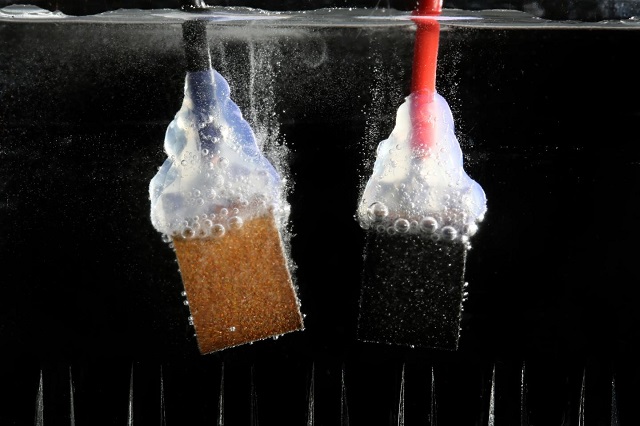 When an electrical current is provided, water splits into oxygen and hydrogen. Credit: EPFL / LPI / Alain Herzog
When an electrical current is provided, water splits into oxygen and hydrogen. Credit: EPFL / LPI / Alain Herzog
EPFL researchers have succeeded in combining perovskite solar cells and nickel iron catalysts to obtain an amazing 12.3 solar to hydrogen efficiency.
The EPFL Laboratory of Photonics and Interfaces, headed by Michael Grätzel, is credited with the invention of dye solar cells that can imitate plant photosynthesis. The laboratory is also recognized for developing techniques for generation of fuels through water splitting using solar energy.
To achieve this feat, they would have used either photoelectrochemical cells for instantly splitting water into oxygen and hydrogen when exposed to sunlight, or electricity-generating cells coupled with an electrolyzer to divide the water molecules.
Jingshan Luo (Grätzel's post-doctoral student) and team at the lab used the second method. The device they built was able to convert 12.3 %of energy diffused by the sun into hydrogen using perovskite absorbers. These absorbers are a type of compound that can be generated in a lab from common materials like traditional car batteries, thereby removing the need for rare-earth metals in the generation of hydrogen fuel.
Their method has several benefits when compared to other traditional solar energy conversion techniques. Luo stated that the combination of perovskite cells and nickel and iron catalysts used in the electrodes are an inexpensive resource available in the Earth. In addition, these electrodes operate in a similar manner like expensive customized platinum electrodes.
A 12.3% efficient solar to hydrogen conversion with low-cost, earth-abundant materials
Science published on Sept. 25, 2014 the latest developments in Michael Grätzel's laboratory at EPFL in the field of hydrogen production from water. By combining a pair of perovskite solar cells and low price electrodes without using rare metals, scientists have obtained a 12.3% conversion efficiency from solar energy to hydrogen, a record with earth-abundant materials. Jingshan Luo, post-doctoral researcher, explains how.
This method overcomes the greatest challenge of efficiently storing hydrogen fuel following the solar energy conversion. According to Michael Grätzel, the stored hydrogen can be used anytime based on the requirement, for burning in a boiler to release water vapor or producing electric energy by passing through a fuel cell. He also expressed the possibility of increasing the energy conversion efficiency of 12.3% achieved by them.
Both the perovskite used in the cells and the nickel and iron catalysts making up the electrodes require resources that are abundant on Earth and that are also cheap. However, our electrodes work just as well as the expensive platinum-based models customarily used.
Jingshan Luo, post-doctoral researcher
High values can be achieved because of the nature of perovskite cells, which can produce an open circuit voltage that is greater than 1 V. Luo illustrates that to achieve a voltage of 1.7 V or more, more silicon cells will be needed whereas this voltage is easily achievable with two perovskite cells. For the first time, hydrogen was procured via electrolysis aided by just two cells.
Going forward, Grätzel’s method seems to be a very probable means of creating energy.
References